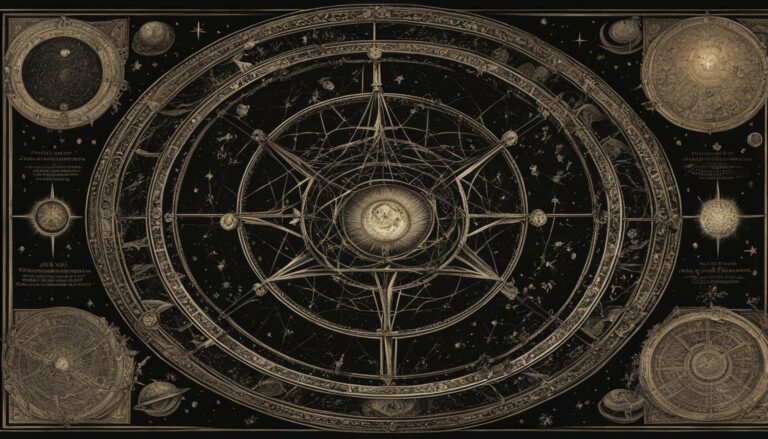What Does Mutual Reception Mean in Astrology?
Mutual reception in astrology is a fascinating phenomenon that involves a special connection between two planets. It occurs when one planet is located in the sign ruled by the other, and vice versa. This creates a powerful link and influence between the two planets, enhancing or debilitating their various functions. Mutual reception can occur through different aspects such as conjunction, sextile, square, trine, opposition, or inconjunction.
- Mutual reception is a concept in astrology that describes a special connection between two planets.
- This connection occurs when one planet is located in the sign ruled by the other, and vice versa.
- Mutual reception enhances or debilitates the functions of the planets involved.
- It can occur through conjunction, sextile, square, trine, opposition, or inconjunction aspects.
- The effects of mutual reception are strengthened or weakened based on the dignity of the planets.
Understanding Mutual Reception in Astrology
Mutual reception in astrology occurs when two planets are located in the signs ruled by each other, creating a unique connection and influencing their energies. This concept enhances our understanding of planetary interactions and provides valuable insights into a person’s natal chart.
When planets are in mutual reception, they establish a special bond that deepens their connection. This bond can occur through various aspects such as conjunction, sextile, square, trine, opposition, or inconjunction. Each aspect has its own distinct influence on the mutual reception dynamic.
The effects of mutual reception are further influenced by the dignity of the planets involved. Planets that are strongly dignified bring about a harmonious and supportive energy exchange, strengthening the connection between them. On the other hand, planets that are weakly dignified may create challenges and disruptions in their interaction.
The houses in which planets in mutual reception are found are also closely linked. This linkage adds another layer of complexity to the interpretation of mutual reception in a natal chart. Understanding these linked houses provides deeper insights into how the planets’ energies interact and manifest in an individual’s life.

To summarize, mutual reception in astrology refers to a special connection between two planets when one is located in the sign ruled by the other, and vice versa. This unique bond enhances or debilitates the functions of the planets involved, depending on their dignity. The houses in which these planets are found further influence their interactions and energies. By understanding mutual reception, astrologers gain valuable insights into planetary connections and the dynamics within a natal chart.
The Significance of Mutual Reception in Astrology
Mutual reception holds significant meaning in astrology and plays a crucial role in understanding the dynamics of a natal chart. It refers to a special connection between two planets when one is located in the sign ruled by the other, and vice versa. This creates a link and influence between the two planets, enhancing or debilitating their various functions.
When two planets are in mutual reception, it signifies a harmonious exchange of energies. This connection adds depth and complexity to the interpretation of a natal chart, providing valuable insights into the interactions and dynamics between the planets involved. Astrologers analyze mutual reception to gain a better understanding of an individual’s personality traits, strengths, challenges, and potential life experiences.

The Astrological Concept of Mutual Reception
Within the astrological concept of mutual reception, the houses in which planets in mutual reception are found are closely linked. This further influences the interactions and energies between the planets, providing additional layers of insight. The linked houses facilitate a flow of energy and connection between the planets, influencing various aspects of the individual’s life and experiences.
The effects of mutual reception are strengthened or weakened depending on the dignity of the planets involved. Planets in their own signs or exalted positions have a higher level of dignity and exert a stronger influence within the mutual reception connection. Conversely, planets in their detriment or fall have a lower level of dignity and their influence may be diminished.
Mutual reception adds depth and nuance to astrological interpretations, offering a multi-dimensional understanding of the planetary connections within a natal chart. This intricate interplay between planets and signs provides astrologers with valuable insights into an individual’s unique characteristics and life path.
The Types of Aspects in Mutual Reception
Mutual reception can occur through several types of aspects, each influencing the connection between the planets involved in unique ways. Let’s explore these aspects and how they contribute to the dynamic of mutual reception:
- Conjunction: This aspect occurs when two planets are closely positioned together, sharing the same degree of the zodiac. It intensifies the connection and energy exchange between the planets, magnifying their combined influence.
- Sextile: In a sextile aspect, two planets are approximately 60 degrees apart. This harmonious aspect encourages cooperation and synergy between the planets, allowing them to work together in a balanced manner.
- Square: A square aspect occurs when two planets are approximately 90 degrees apart. It brings forth tension and challenges, pushing the planets to face obstacles and make necessary adjustments in order to achieve growth and transformation.
- Trine: The trine aspect forms when two planets are approximately 120 degrees apart. This harmonious connection facilitates a flow of positive energy, enhancing the planets’ abilities to work together effortlessly towards common goals.
- Opposition: An opposition aspect arises when two planets are approximately 180 degrees apart. This polarizing connection highlights opposing forces, creating a need for balance and integration between the planets’ energies.
- Inconjunct: Also known as a quincunx, this aspect occurs when two planets are approximately 150 degrees apart. It represents a subtle, yet challenging connection that requires adjustment and adaptation to navigate conflicting energies.
Understanding these various aspects helps astrologers interpret mutual reception in a natal chart, giving valuable insights into the relationship and dynamics between the planets involved.
Strengthening or Weakening Effects of Mutual Reception
The effects of mutual reception can vary in strength depending on the dignity of the planets involved. When the planets involved in mutual reception are in their own signs or exalted, their connection is strengthened, and their functions are enhanced. This creates a harmonious and supportive energy between the planets, allowing them to work together seamlessly.
On the other hand, if the planets involved in mutual reception are in signs where they are in detriment or fall, their connection is weakened. This can result in a more challenging and conflicting energy between the planets, making it harder for them to cooperate effectively.
It is important for astrologers to consider the dignity of the planets when interpreting mutual reception in a natal chart. Understanding the strength or weakness of the connection can provide valuable insights into how the planets interact and influence each other’s energies.
Factors Affecting the Strength of Mutual Reception:
- The planets’ placement in their own signs or exaltations
- The planets’ placement in signs where they are in detriment or fall
- The nature of the aspect formed through mutual reception
- The overall balance of elements and qualities in the natal chart

By understanding the factors that strengthen or weaken the effects of mutual reception, astrologers can gain a deeper understanding of the dynamics at play in a natal chart. This knowledge allows for more accurate and nuanced interpretations, providing valuable insights into an individual’s personality, strengths, challenges, and potential life experiences.
In the next section, we will explore the linked houses in mutual reception and how they further influence the interactions and energies between the planets.
The Linked Houses in Mutual Reception
When planets are in mutual reception, the houses they occupy are closely linked, creating a deeper interplay of energies. This connection between the houses in astrology adds another layer of significance to the mutual reception dynamic. It influences the interactions and influences of the planets involved, providing valuable insights into a person’s natal chart.
For example, let’s say that Mercury is in the sign ruled by Venus, which is Libra, and Venus is in the sign ruled by Mercury, which is Gemini. In this case, there is a mutual reception between Mercury and Venus. Now, if we look at the houses that these planets occupy in the natal chart, we can gain further understanding of how their energies interact. If Mercury is in the 7th house, which represents relationships and partnerships, and Venus is in the 3rd house, which governs communication and siblings, we can interpret that there is a strong link between relationships and communication in this person’s life.
Furthermore, the linked houses in mutual reception can provide insights into the areas of life where these planets’ influences are most pronounced. It can highlight specific themes or focus areas that need attention or exploration. Understanding the interconnectedness of the houses in mutual reception allows astrologers to provide more accurate and nuanced interpretations of a person’s natal chart.
Key Points:
- Mutual reception creates a connection between two planets when one is located in the sign ruled by the other.
- The linked houses in mutual reception further enhance the interplay of energies between the planets involved.
- Interpreting the linked houses provides valuable insights into specific areas of life where these planets’ influences are most pronounced.

Understanding the linked houses in mutual reception enhances our understanding of the complexities and dynamics within an individual’s natal chart. It provides deeper insights into the interrelated areas of life and the energies at play. By considering both the planets involved and the houses they occupy, astrologers can paint a more detailed and accurate picture of a person’s personality traits, strengths, challenges, and potential life experiences.
Mutual Reception in Natal Chart Interpretations
Mutual reception is a significant aspect of natal chart interpretations, offering valuable insights into an individual’s astrological profile. It refers to a special connection between two planets when one is located in the sign ruled by the other, and vice versa. This creates a powerful link and influence between the two planets, shaping their functions and interactions in the birth chart.
When analyzing mutual reception in a natal chart, astrologers pay attention to the specific aspects through which it occurs. Whether it’s a conjunction, sextile, square, trine, opposition, or inconjunction aspect, each configuration brings its own dynamics and energies to the mutual reception connection. These aspects further enhance or debilitate the influence of the planets involved, creating a unique astrological signature for the individual.
The dignity of the planets plays a crucial role in determining the strength of the mutual reception. Planets in their rulership or exaltation are considered dignified, amplifying their impact within the mutual reception connection. Conversely, planets in their detriment or fall may weaken the effects of mutual reception. The strength or weakness of the planets involved can provide valuable clues about an individual’s personality traits, strengths, challenges, and potential life experiences.
The Linked Houses in Mutual Reception
Furthermore, the houses in which the planets in mutual reception are found are closely linked, adding another layer of insight to the interpretation. The energies of the linked houses intertwine, creating a complex web of influences and connections within the natal chart. By examining these linked houses, astrologers gain a deeper understanding of the areas of life affected by the mutual reception.
Overall, mutual reception offers a profound understanding of an individual’s astrological makeup. It provides a unique perspective on the planetary connections and energies at play in a natal chart, allowing astrologers to provide in-depth and accurate interpretations. By considering the aspects, dignity of the planets, and the linked houses, astrologers can offer valuable guidance and insights into an individual’s life path, strengths, challenges, and potential for personal growth.

To better grasp the concept of mutual reception, let’s take a look at some examples in astrology. Mutual reception occurs when two planets are in each other’s ruling signs, creating a special connection and influence between them. This connection enhances or debilitates their functions, leading to unique dynamics in a natal chart.
One example of mutual reception is the exchange between Venus and Mercury. Venus rules Taurus and Libra, while Mercury rules Gemini and Virgo. When Venus is placed in Gemini and Mercury is placed in Taurus, they form a mutual reception. This exchange enhances communication (Mercury) and love (Venus) in the natal chart, emphasizing the importance of intellectual connections and harmonious relationships.
Another example is the mutual reception between Mars and Jupiter. Mars rules Aries and Scorpio, while Jupiter rules Sagittarius and Pisces. When Mars is placed in Pisces and Jupiter is placed in Scorpio, mutual reception occurs. This exchange highlights the blending of assertiveness (Mars) and expansion (Jupiter), creating a potent combination of ambition, intuition, and spiritual growth.
Mutual Reception Example: Venus in Gemini and Mercury in Taurus
- Venus in Gemini enhances intellectual connections and communication skills.
- Mercury in Taurus emphasizes the importance of stable and harmonious relationships.
- The mutual reception between Venus and Mercury intensifies these qualities, promoting the need for stimulating conversations and deep emotional connections.
Mutual Reception Example: Mars in Pisces and Jupiter in Scorpio
- Mars in Pisces combines assertiveness with intuition, leading to a compassionate and adaptable approach to achieving goals.
- Jupiter in Scorpio expands the transformative power of passion and intensity.
- The mutual reception between Mars and Jupiter intensifies these energies, fostering a strong appetite for spiritual growth and a drive to explore deep emotions and hidden truths.
These examples highlight the dynamic interplay between planets in mutual reception and how it enriches astrological interpretations. By understanding these examples and exploring more combinations, astrologers can gain deeper insights into personality traits, potential life experiences, and the overall energies present in a natal chart.

Mutual reception in astrology is a profound concept that enhances our understanding of planetary influences and their interactions in a natal chart. It refers to a special connection between two planets when one is located in the sign ruled by the other, and vice versa. This creates a link and influence between the two planets, amplifying or diminishing their various functions.
When planets are in mutual reception, their effects can manifest through various aspects such as conjunction, sextile, square, trine, opposition, or inconjunction. These aspects further contribute to the dynamic and complex nature of mutual reception. The effects of mutual reception are also influenced by the dignity of the planets involved.
The houses in which planets in mutual reception are found are closely linked, adding additional layers of insight to their interactions. This close link between houses further enhances the understanding of the dynamics and energies between the planets involved. Astrologers analyze and interpret mutual reception in natal chart readings to gain valuable insights into an individual’s personality traits, strengths, challenges, and potential life experiences.
By examining specific planetary combinations in mutual reception, we can see how this concept manifests in real-life scenarios. Through these examples, we gain a deeper appreciation for the intricate and interconnected nature of astrology. Mutual reception provides a unique perspective on the energies and dynamics within a natal chart, allowing us to explore and understand the complexities of an individual’s astrological makeup.
FAQ
Q: What does mutual reception mean in astrology?
A: Mutual reception in astrology refers to a special connection between two planets when one is located in the sign ruled by the other, and vice versa. This creates a link and influence between the two planets, enhancing or debilitating their various functions.
Q: How does mutual reception affect planetary connections?
A: Mutual reception enhances or debilitates the functions of the planets involved. It can occur through conjunction, sextile, square, trine, opposition, or inconjunction aspects, strengthening or weakening their effects depending on the dignity of the planets.
Q: What is the significance of mutual reception in astrology?
A: Mutual reception provides valuable insights into the dynamics and energies in a natal chart. It helps astrologers interpret the connections between planets and understand an individual’s personality traits, strengths, challenges, and potential life experiences.
Q: What are the types of aspects in mutual reception?
A: Mutual reception can occur through conjunction, sextile, square, trine, opposition, or inconjunction aspects. These aspects contribute to the mutual reception dynamic and influence the interaction between the planets involved.
Q: How do the effects of mutual reception strengthen or weaken?
A: The effects of mutual reception can be strengthened or weakened depending on the dignity of the planets involved. Planets in strong dignity enhance the effects, while planets in weak dignity diminish their influence within the mutual reception connection.
Q: How are the houses linked in mutual reception?
A: The houses in which planets in mutual reception are found are closely linked. This further influences the interactions and energies between the planets, providing additional layers of insight into the astrological interpretation.
Q: How is mutual reception interpreted in natal chart readings?
A: Astrologers analyze and interpret mutual reception in natal chart readings to gain a better understanding of an individual’s personality traits, strengths, challenges, and potential life experiences. It provides valuable insights into the dynamics and energies within the chart.
Q: Can you provide examples of mutual reception in astrology?
A: Certainly! Examples of mutual reception in astrology include scenarios where, for instance, Venus is in the sign ruled by Mercury, while Mercury is in the sign ruled by Venus. This creates a mutual influence and connection between the planets, affecting their functions and interactions.







